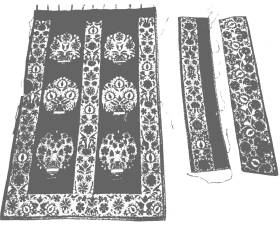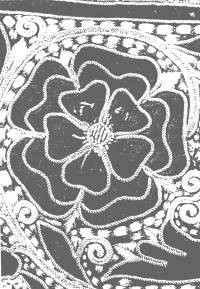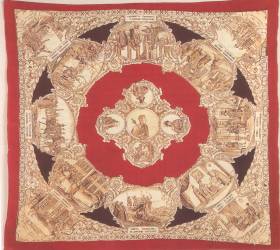Vilan
van de Loo,
Toekomst door traditie. 125 jaar Tesselschade-Arbeid
Adelt,
Zutphen 1996, 216 pp., illustrated in black and white and
colour, text in Dutch, bibliography
Summary by Pat Griffiths
This book provides an
excellent survey of the history of the two societies
founded in the Netherlands in the early 1870s to help
impoverished gentlewomen to earn a living by needlework.
Arbeit Adelt (Work Enobles) was started in 1871;
Tesselschade (named after Maria Tesselschade Roemer
Visscher, 1594-1649, a famous poet, glass-engraver and
embroiderer) began the following year as a result of a
split in Arbeit Adelt.Tesselschade in particular played
an important role in the art needlework movement and the
effort to improve standards in needlework by publishing
two influential books. Pressure from both societies led
to the establishment in 1883 of an Art Needlework Class
in the National Applied Arts School under Ida Winkler
(1861-1950), a teacher brought in from Vienna, and the
institution of new needlework exams in schools in 1885.
The societies sold
needlework at bazaars, exhibitions and their own shops
all over the country, while later helping women to find
work in other ways, e.g. by running courses for
"mother’s helps" and by advertising posts
as carers. In 1905 a similar society was set up in the
then Dutch East Indies under the name Roemer Visscher for
the benefit of European and Indo-European women. This
survived until the end of the fifties. In the twenties
Arbeit Adelt helped a women’s orgnization in Hungary
by sending materials to women there and selling their
products in the Netherlands.
Both organizations managed
to survive the difficult years of the thirties and even
the Occupation. Ironically, the situation proved more
difficult after the war in some ways, partly because of
government restrictions, but also because more
opportunities were now open to women and standards in
needlework had again fallen. All this eventually led to
the societies deciding to amalgamate in 1952. After that
their work continued much as before, a commission for
cloths and bookmarks embroidered in silk and gold coming
to the Rotterdam branch in 1954 from the Dutch church of
Austin Friars in London (it would be interesting to know
if these pieces are still in existence). Since the
seventies they have also given grants to enable women to
take courses in a wide range of subjects: the author of
this book was enabled to complete her studies at Leiden
University, while at the other extreme a girl was helped
to learn oxy-acetyline welding!
Although the societies
originally led the way in reforming needlework in the
Netherlands, the work they produce nowadays is all too
traditional: smocked garments for children, samplers or
linen objects with sampler motifs of floral embroidery,
dressed dolls, soft toys, ets. The standard of the
needlework remains a constant concern: in 1993 a Fine
Needlework Committee was formed to try to bring back
techniques such as drawn thread work, which had almost
died out. Enthusiasts can still be found both to do and
organize the work: there are now over 11’000 members
all over the country, while 100’000 guilders are
given out every year in grants and the turnover of the
needlework amounts to around a million guilders. Both
societies have always enjoyed royal patronage and their
125th anniversary was celebrated earlier this year by an
exhibition at the royal palace Het Loo.
S.
Grieten & J. Bungeneers (eds),
Inventaris van het Kunstpatrimonium van de Provincie
Antwerpen. Deel 3. De Onze-Lieve-Vrouwekathedraal van
Antwerpen. Kunstpatrimonium van het Ancien Regime,
Antwerp 1996, the text in Dutch (Flemish) comprises
an introduction and 1106 entries, lavishly illustrated in
black and white and colour, bibliography
Summary by Pat Griffiths
This splendid publication
not only covers all the art objects (movable and
immovable) in Antwerp Cathedral, but also lists items now
lost, but recorded in inventories. Thus it is a mine of
information on the rich textile collections, which have
been catalogued by Frieda Sorber.
Embroidery is to be found
in abundance in the sections on altar frontals
(pp.28-37), liturgical textiles (pp. 273-280, 297-310),
ornaments and clothes for images (pp. 352-4) and
miscellaneous textiles (p. 495-7). As a result of various
terrible events in the 16th century: a great fire in
1533, the iconoclasm in 1566 and the removal of church
furniture and art treasures under the Calvinists in 1581,
nothing survives from before c. 1600. However some
of the rich variety of embroideries after that date are
very well documented. A notable example is a set of Tree
of Jesse vestments made for the Guild of Our Lady in
1608-10 (No.844), for which the chasuble-maker Joos
Geertssens embroidered the orphreys and hood (with the
Virgin & Child & St Anne) of the cope and parts
of the other vestments, while Hans Gillis embroidered
figures from Jesse’s line on the dalmatics and
François Hennekin did the Trees of Jesse on the chasuble
orphreys and finished the borders of the sleeves of the
dalmatics. In 1779-80 J.F. Melsens was paid for repairing
the vestments and embroidering flower motifs in silk,
chenille, sequins and gold and silver thread on them.
An interesting piece of
secular embroidery given to the cathedral is a dress
belonging to Maria Alexandrina Ursula Josepha de Fraula,
which was presented by her widower, Philip Louis, Baron
van de Werve de Schilde in 1770, a panel from which was
made into a tablier for the image of the Virgin (no.920).
The Virgin’s wardrobe also included a ‘veil,
tablier and side pieces for the image of the Holy Mother
of God and a robe for the Child’ made by the J.F.
Melsens mentioned above.
The book is also valuable
for the documentary evidence relating to pieces now no
longer extant. This goes back to the 15th century and
contains a wealth of fascinating information. For
instance, in 1477 the churchwardens paid the embroiderer
Heynric de Duytsche for repairing and ornamenting three
old orphreys they had bought that year (p.284) and in the
same year he accompanied them, no doubt to give advice
and moral support, when they went to make an expensive
purchase of red cloth of gold for three copes, a chasuble
and two tunics (p.300).
Another interesting
reference shows an embroiderer supplying a wide range
of materials. In 1523 the Guild of Our Lady bought
from Lenart Sallet fifteen ells of white damask with gold
flowers to make a chasuble. For this the embroiderer
Paulus (probably Pauwel von Malsen, see also below)
supplied the orphreys, fringes, silk ribbon, gold buttons
and lining cloth (p. 274).
Gifts and bequests by
private individuals include that made on 25 July 1561
by Cornelis de Vos and his wife Anne Velincx of a
chasuble with a cross orphrey in gold relief embroidery,
a dalmatic and a tunicle, both with gold orphreys and an
altar frontal. These items were made of white damask and
bore the embroidered arms of the Velincx family (p. 300).
Most fascinating of all,
perhaps, is the chasuble ordered by the
Merchants’ Guild in 1520 (p. 273). This was of
cloth of gold embroidered with gold thread, pearls and
silk and bearing a rendering of St Nicholas, the
guild’s patron saint. The embroiderer Pauwel van
Malsen made the orphreys with their borders of gold
relief embroidery and with large and small English
pearls. The Painter Gommaar and another unnamed painter
supplied designs for a pattern, while the figure of St
Nicholas was designed by none other than Albrecht
Duerer, who was in Antwerp at the time. The cloth of
gold for the vestments was paid for in 1521, the
embroiderers’ fees in 1522. In 1538 the embroiderer
Peeter Bollaert was called in to replace a number of
pearls that had fallen off and to do some additional
embroidery: two renderings of St Nicholas and four
medaillions, probably with a pair of scales, the
guild’s emblem. Further repairs were carried out in
1602-4, but on 3 July 1730 it was decided to have a new
chasuble made and to have the old one, possibly this one,
burnt to recover the precious metal. Thus perished
a hitherto unknown work by Duerer, alas!
It was presumably the
value of the precious metal that caused a red velvet
altar frontal - embroidered for the Merchants’ Guild
in 1591 with St Nicolas and two renderings of their
emblem and listed in an inventory of 1612 - to be
stolen in 1626. It was replaced by a new frontal in
1629, for which the silk merchant Jacques Cornelis
presented the red velvet and the embroidery was done by
Hieronymus Bernarts (p. 28).
The abundance of material
of this kind in this publication makes it an invaluable
source for embroidery scholars. Moreover I am
informed by Frieda that there is actually a great deal
more documentary evidence available, which could not be
included here, so she plans to publish some of this in
the near future. She also tells me that the cathedral is
by no means the most interesting of the Antwerp churches
as far as textiles are concerned. One can only wait with
bated breath for further Kunstpatrimonium publications!
|






